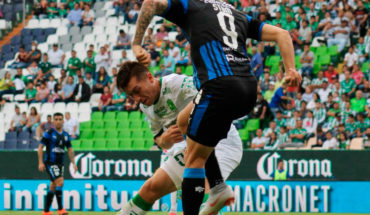Although his career was not as prolific (known you hardly more than 25 paintings in total), Leonardo da Vinci is without doubt one of the most influential artists in the history of Western art, as shown by the multiple reversions that exist of his works more known.
La Gioconda, in two of its modern reversals: on the left, that of Andy Warhol; on the right, that of Duchamp. L.H.O.O.Q. sounds in French, such as “elle a chaud au cul”. Google translation can…
His obsession to imitate nature precisely as possible led him to perfect the technique of sfumato – which consists of approximate two abutting colors to make contours look as a continuum, not a break–and to consider a particular use of the perspective, the technique used to represent three dimensions on a drawing. The sfumato allows Leonardo give your pictures a relief never achieved until then, which gives them a greater likelihood. According to Giorgio Vasari, considered the founding father of the history of art, in general the vinciano was responsible for adding “to the oil color style a certain darkness that extracted the modern great strength and relief of his figures”. The importance of the technique, of which Leonardo himself was well aware, can be clearly seen in La Gioconda; for example, in the shadow of eyes or at the junction between the face and the hair. Other two great pictorial achievements of da Vinci are on the one hand, the handling subtle proportions (in particular, those of the man) and, on the other hand, the expression of the passions and emotions of human beings. In both cases, fulfilled a key role his obsession with the scientific study of anatomy.
Some of the anatomical drawings of Leonardo
It is no coincidence that Leonardo, in accordance with the trend of the time, attempted to raise to the painting above all the other arts, as and when required combined with subtlety the accuracy of mathematics and geometry with a rigorous exercise and requires e. painter, became a sort of demiurge, capable of creating new worlds that respond to their own desire:
If the artist wants to see beauties that fall in love with him, he is owner of fathering them, and if you want to see the monstrous things that scare, or that are comical and laughable that truly inspire compassion, he is also Lord and God [de ellas]. And if you want to generate sites and deserts, forests shaded or dark for the warm days, he represents them, and the same done with warm places in the cold times. If you want to valleys, if you want to from the high peaks of the mountains discover a large expanse of countryside, and if you want beyond those to see the horizon of the sea, he is also owner and Lord, so if you want to see from the valleys low the high mountains , or from the high mountains, the valleys low and beaches. And indeed, that exists in the universe by essence, presence or imagination, the painter has it first in the mind and then hands; and these are of such excellence that soon they beget a harmony provided for a single look, just as they do things.
In what follows, we present some of the most renowned paintings by Leonardo, in which you can see perfectly the use of perspective, the sfumato and representation of bodies and human emotions.
Enter as an apprentice in the workshop of Andrea de el Verocchio, one of the main schools of paintings and sculptures from Florence. There to learn different art techniques, but also principles of mechanics, calculation, metallurgy and woodworking. His exceptional talent stands out from the beginning. According to a legend which tells Giorgio Vasari in his famous book the lives of the most excellent painters, sculptors, and architects (1550), standing left a painting that Da Vinci was working when he was overcome by the mastery of his disciple.
The baptism of Christ, the joint work of Andrea de el Verocchio and Leonardo da Vinci
Paints the Annunciation, the best-known work of its first stage as an artist. The picture represents the moment in which the Archangel Gabriel announces to Mary the arrival of Christ. Already the delicate use of the sfumato can be seen.
The picture, of 98 cm. high by 217 cm. wide, is preserved in the Gallery of the Uffizi Gallery in Florence
Leonardo had installed since the previous year in Milan to put at the service of the Duke Ludovico Sforza, who had sent him a letter which today can be read as a compelling resume. Paints in this year, commissioned by the confraternity of the Immaculate Conception, the Virgin of the rocks.
The Virgin of the rocks, in the version that remains in the Louvre
Santa María de las Gracias, in Milan, paints the last supper in the refectory of the convent by order of Ludovico Sforza. The moment represented is in which Jesus tells his Apostles that one of them would betray him.
In the book De divina proportione, published in 1509, Luca Pacioli says:
To such extent that perfectly mimics nature painting. And is something that is evident in our sight in the exquisite simulation of the burning desire of our salvation, in which it is not possible to imagine the Apostles to paying greater attention to the sound of the voice of the infallible truth when he said: unus vestrum me traditurus est.
Judas is depicted in shadow and with a bag in hand, with the coins you receive in Exchange for betrayal. Each of the Apostles has a particular expression, which manifests itself not only in their faces but in their hands.
The last supper, one of the most influential paintings of history
Leonardo works on a portrait of the spouse of Francesco del Giocondo, but fails to finish it in time, and carries it with him when part again to Milan and, later, when he travels to France, where he died in 1519. The picture is part of the Royal collection until since 1793, it is displayed in the Louvre. It is, of course, of the Mona Lisa, also known as Monna Lisa.
Giorgio Vasari says of the portrait:
There were imitated all the minutiae that it is possible to paint with subtlety. As the eyes had those glitters and those wetlands that continuously are seen in people
Vivas, and around them were all these red spots and those hairs which can be but with great subtlety. Eyebrows, by having represented the mode of birth the hairs in the flesh, ora more dense, ora more sparse, and the way in which they rotate according to the pores of the meat, couldn’t be more natural. The nose, with all these openings pink and tender, was alive. The mouth, with her cleavage, with ends joined by Red’s [los labios], more the incarnate of the face, did not seem to colors but real flesh (…). [Leonardo] He also used the following trick: that, for being the beautiful lady Lisa, maintained, while he portrayed it, those who touch an instrument or sing, and continuously buffoons making it to be happy, to eliminate the melancholy that tends to give the paint often the portraits she produces; and in this, made by Leonardo, had a smile so pleasing that it was something more divine human looking at it, and considered it something wonderful because it was not different from the living thing.
The Mona Lisa is the main attraction of the Louvre





